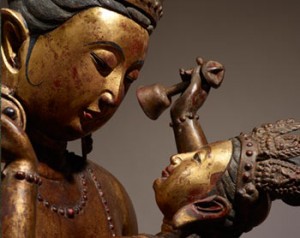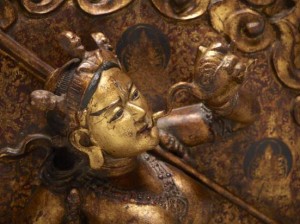Explore the Art of Tantric Buddhism at the Crow Collection
The Crow Collection of Asian Art opened its new show, Noble Change: Tantric Art of the High Himalaya last weekend. The exhibit contains eleven gorgeous copper Buddhist sculptures as well as one embroidered silk panel and represents work acquired by Trammell Crow last year for his private collection.
While I guarantee you’ll get lost amongst the glistening pieces, this exhibit is about much more than aesthetic pleasure. This is part of what will be over the next several years an important project for the Crow Collection; introducing Dallas museum-goers to the hyper-relevant practice of Tantric Buddhism. Spoiler alert, this is not an article about sex.
According to Crow Collection Curator Dr. Caron Smith, the principles of Tantric Buddhism have in the past been dismissed as “titillating erotica or stultifying ritual†and during the 1960’s, were appropriated by the Hippie culture as a justification for their pursuit of un-inhibited sexual pleasure. Smith states, “The time is ripe to reveal tantra for what it is truly intended to be.
The teachings of tantra are part of Vajrayana Buddhism, a form of the complex and constantly evolving teachings of the Buddha that arose in the 6th or 7th centuries and is especially prevalent in the Himalayan countries of Tibet, Nepal and Mongolia amongst others.
Like all forms of Buddhism, the base of tantric teaching lies in the four noble truths: The truth of suffering: the truth of the origin of suffering: the truth of the cessation of suffering: and the truth of the path of the cessation of suffering.
In tantric Buddhism students use suffering and other negative aspects of existence in order to achieve a higher state of being, one in which the goal is to reach a simple life through reflection and the emptying out of themselves.
When exploring the intimate gallery space at the Crow it’s vital that the viewer leave preconceptions outside. This work is highly symbolic, overtly sexual and somewhat complicated, but don’t let that intimidate you. Keeping in mind the philosophy behind this exhibit while viewing should at least make the works accessible enough to enjoy for more than aesthetic beauty, as they were intended to be.
The deities on view in the exhibit represent various Buddhas. Two Vajradharas, in other words the first Buddha, are represented here, each signifying the unity of male and female. Part of the “revisionism†of tantric Buddhism allowed for a stronger role to be played by the female in the “story,†and in these Dorje Chang (in Tibetan), there is rampant symbolism indicating male aspects in the female, and vice versa.
There are also two Dakinis represented amongst the scultpures. Dakinis in tantric Buddhism are the female embodiment of wisdom and energy. The Sarva Buddha Dakini, or Dakini of all the Buddhas is represented as a young female, innocent and therefore able to serve as the protector, provider of wisdom and home to all. The symbolism in the Naro Khandoma (in Tibetan) is throughout as she treads on Ignorance and Ego and drinks the defilements of all in order to liberate.
The other Dakini in the exhibit is Kurukulla or the Dakini of flowers. Using her feminine seductiveness, Kurukulla is able to subdue and pacify demons. She treads on a naked body representing her dominance over desire and the skulls surrounding her are reminders of death.
You may not need the reminder but this is religious art, not in the sense that it is to be worshipped or even instill reverence, but rather to inspire. It is not “art for art’s sake†in the words of Smith. Dissolving duality (namely that of male and female), embracing the unity of ourselves and using our human form to achieve these aims are central tenets of tantric Buddhism. These exquisite pieces were created in the 17th, 18th and 19th centuries to arouse a desire to improve the world and those living in it.
Thanks to the Crow Collection, westerners have an opportunity to discover the principles of tantra through beautiful, artistic representation. See the exhibit for free at the Crow Collection through February 10, 2013. For hours and special events visit www.crowcollection.org









